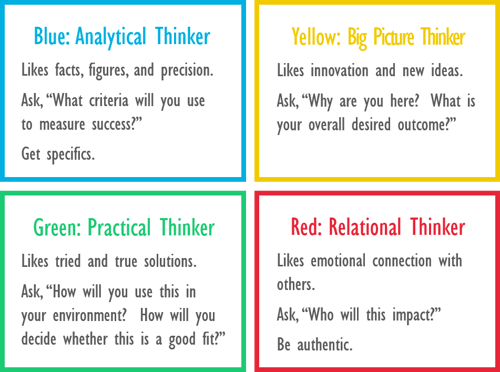 During a sales call or demo, it is easy to be very product-focused. After all, the product is what you’re there to talk about, right?
During a sales call or demo, it is easy to be very product-focused. After all, the product is what you’re there to talk about, right?
In my last post, I talked about why focusing on your product or service during a sales call is the #1 mistake you can make. Your customer wants your conversations to be about him and his needs, and they should be. In this post, I will talk about how to make a successful sales call by focusing on your customer rather than what you’re selling.
Preparing for a customer-focused sales call
The best sales calls use Whole Brain® Thinking to address all four of the thinking styles individuals have. The more decision-makers you’ll be talking to, the more important this becomes. People with different thinking styles think about different things, and thus have different decision criteria. You will need to target all four thinking styles unless you already know how your prospect thinks.
Here are the four thinking styles and what each of them will be concerned about during your product demo. If you listen to your prospect’s comments, you’ll be able to pick up clues about where he or she fits in this table and what his or her thinking style might be.

7 keys to a customer-focused demo
1. Have a written agenda.Use bullet points and write it on a whiteboard. Go over it before your demo begins and use it as a reference for discussion during your presentation. This satisfies the green thinker’s desire for a process and order.
2. Make sure one of your bullet points is “Criteria for success?”.
This where you address a blue thinker’s preferences by asking questions about what they are looking for. It’s also a good time for you to share what criteria others have used, but make sure you do more listening that talking. Ask questions like:
What will make this demo successful for you?
What specifically do you want to see?
What criteria will you be using to judge whether this will meet your needs or goals?
After you share a feature or benefit of your product, ask the buyer, “How do you see this working in your environment?” Getting them to discuss it engages the imagination and causes them to see themselves or their employees using it. This creates emotional buy-in and will appeal to yellow, green, and red thinkers.
4. Do not immediately tell your customer your product can do what he wants.
When a prospect makes a statement about an issue, such as, “I need to lower costs or improve productivity,” do not talk about how your product can deliver that result. Instead, ask a follow-up question, such as, “Tell me more about what you are experiencing,” or “What is going on for you to make that statement?” The more you get your prospect to share, the more information you will have to identify their thinking style and decision criteria. Their answers will give you clues about how they think.
The same rule applies if your customer makes an unsolicited comment about what they think your product will do. For example, suppose you are talking about a fryer for a restaurant and your buyer says, “This fryer will save us labor.” Stop the demo and focus on that issue. Ask questions like:
Please tell me more. How much labor will it save?
What is the cost of the labor?
Where could the staff’s time be spent instead of having to be filtering the oil? Could they go home earlier or do something else that is productive?
How could this labor savings or efficiency increase impact your restaurant?
What dollar value would you place on this fryer’s impact on your overall bottom line?”
By doing this, you will have your customer calculating the return on investment immediately.
5. Have a calculator handy and know how to calculate ROI quickly.
This will appeal to blue thinkers. Ask the buyer how they would calculate savings. Using the fryer example from above, suppose your buyer says the machine will save three hours a week in labor. You calculate:
3 hours per week x $9.50 hourly rate x 52 weeks a year = annual savings of $1482
Or suppose your prospect is considering buying a new soft-serve machine. He anticipates selling 10 servings per day at $2.50 each. You calculate:
10 servings per day x $2.50 x 300 days per year = annual revenue increase of $7,500, minus cost of materials.
6. Lastly, ask risk based questions.
Ask questions such as:
What would keep this product from working in your environment?
What are your key concerns as you consider implementing this in your business?
Are there any concerns about cleaning the machine or training your staff, etc.?
How do you see your team embracing a new program?
Do you see any pushback because this is new and people are resistant to change?
Once you have these answers, you know what criteria to address while you give your demo. As you show a feature on the fryer that reduces cooking time, you can relate that specific feature to the buyer’s criteria. If the buyer is wanting to increase revenue, you can show the profit margins and volume your product, such as a soft serve machine, can deliver on a busy Saturday night. You can relate your services to their specific requirements and demonstrate how your services back up or protect their investment and produce savings.
7. Do a proper demo wrap-up:
- Conclude with a summary discussion.
- Ask, “Did the demo meet your expectations and criteria?”
- Review their decision criteria.
- Review how they would use the product.
- Identify the next step and write it down on the whiteboard.
- Tell the buyer you will send a meeting summary of the demo; then send it the next day.
In summary, before you make a presentation on your product, get the buyers criteria. Once you have that information, you can relate the features, benefits, and outcomes to their specific situation. That makes your presentation relevant to them and helps them see how your product and services can positively impact their business. Your presentation is no longer generic, but customized to their specific situation.
Above all, remember that focusing on the customer means listening more than you talk. The more you can engage your buyer, the more information he will give you about what you can do to address his concerns and desires and close the sale. That is the secret to increasing sales through Customer Aligned Selling™.
To learn how to utilize Whole Brain® Thinking and turn a difficult prospect into an easy one, attend a Whole Brain® Thinking workshop at the end of August, 2017. Act now and get special summer pricing!

